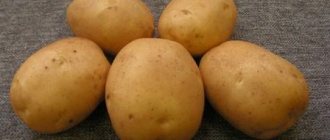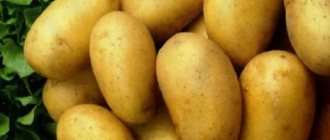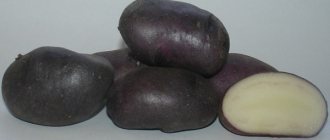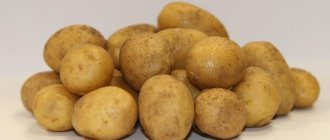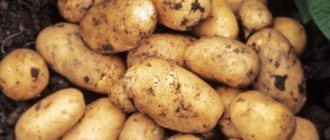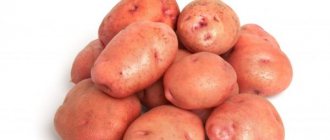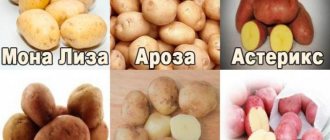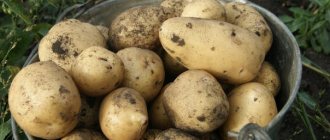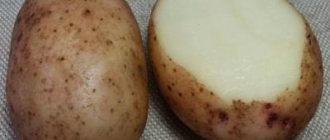The Colombo potato, or more correctly “Colomba”, was developed by Dutch scientists from the agricultural company HZPC HOLLAND BV. Colombo was created by crossing varieties such as Carrera and Agata.
In 2013, Colombo was included in the State Register of the Russian Federation and is positioned for cultivation in 5 regions: Northwestern, Central, Volga-Vyatka, Central Black Earth and North Caucasus.
The variety instantly gained recognition among gardeners, in particular due to its rapid ripening period (about 2 months).
Today we will present a description of the variety, photos and reviews of gardeners who have managed to get acquainted with this young crop.
Characteristics of the variety
The Colomba potato belongs to the very early table varieties. Under ideal conditions, full ripening of the fruit occurs 50 days after placing the potato in the ground. On average, harvesting can be done in 60-65 days.
Productivity is high and stable. With commercial cultivation, it is often possible to achieve figures of 420 centners per hectare. Under normal conditions, you can easily achieve figures of 220-350 c/ha.
The tuber is dense, not crumbly. The starch content in the composition ranges from 11-15%. The percentage of starch in the root crop directly depends on the quality of the soil on the site. The more nutritious it is, the more starch there will be in the potato. The less organic matter, the denser the tuber will be.
During harvest, there are, on average, 10-12 potatoes per hole.
Tuber characteristics:
- Shell color is yellow.
- The color of the pulp is yellow.
- Root weight: 80-130 g.
Description of the bush, tubers
Judging by the description of the Colombo potato variety, the plant is an upright growing bush, reaching a height of 50 cm. The leaves are oblong, dark green in color. The flowers are small in size, painted in light lilac tones.
The tubers reach a weight of 110 g, have a rounded-oblong shape, and a light beige color. The integumentary membrane is without roughness and has eyes located on it. The pulp is light yellow in color and becomes crumbly when cooked. The potato tastes great.
The Colombo variety is characterized by early ripening. According to reviews from potato growers, harvesting can begin 60 days after planting. Productivity in any year is always high. Under the bush there can be up to 15 tubers, reaching a good size by the time of harvesting.
On industrial plantations, 40 tons of Colombo potatoes are harvested per hectare. In the south of the Russian Federation, where the warm period lasts for a long time, it is possible to grow 2 crops per year. However, the soil is depleted.
Photo. Colombo potato variety
Colombo tubers have good taste. The amount of starch in the pulp is 15%. The tubers are stored quite well without loss of taste.
Pros and cons of Colombo
Despite the fact that Russian people have only known the Colomba variety for a few years, they have already managed to determine its advantages for themselves. Among these it is worth noting:
- The ability to maintain a dense structure when boiling or frying. This allows you to use Colombo absolutely everywhere (in particular in salads). Naturally, puree lovers may find this point to be a drawback.
- Excellent taste.
- Good presentation, making Colombo easy to sell on the market.
- Early ripening, which allows you to collect up to two harvests per season in regions with a warm climate.
- Good immunity protecting Colombo from potato cancer.
No shortcomings, as such, have yet been identified.
Diseases and pests
The Colombo hybrid variety is resistant to the main diseases inherent in this crop: scab, nematode, potato cancer. The tops of the plant can be affected by late blight. To exclude the occurrence of the disease, the bushes are inspected regularly during June. Late blight appears as gray or rusty spots on potato leaves and tubers. At the first signs of damage, treat with fungicides.
The Colorado potato beetle is the main pest of potatoes of any variety, including Colombo. The insect and its larvae feed on the tops of the plant. The pest can be controlled by collecting adults and their larvae. You can also use chemicals to kill potato pests.
The cockchafer and its larvae damage the leaves and tubers of the plant. There are no chemicals to combat it. Insects are collected by hand and destroyed. For prevention, do not use fertilizers in the form of compost.
Wireworm is the larva of the click beetle that damages potato tubers. To prevent the appearance of the pest, potatoes are not planted in the area where grain crops grow. The insect is destroyed manually when digging up the area. If this pest is infested in a bed reserved for planting potatoes, it is necessary to use the drug “Barguzin”. The product is applied to the holes immediately before planting the potatoes.
Over time, the immunity of the Dutch hybrid to diseases and pests of vegetable crops decreases. The yield of the variety may also be reduced. Therefore, planting material is periodically updated.
Correct fit
The most suitable time for planting very early potatoes is the period when the leaves on the birch trees begin to bloom. At this time, the soil warms up 8-10 cm deep to +9-10 degrees Celsius. This temperature is acceptable so that the potatoes do not freeze while in the ground.
If the soil is colder, the potatoes will develop more slowly. There is also a risk of tubers rotting.
Only high-quality seed material is allowed before planting. These should be small potatoes the size of a chicken egg without any defects.
Before planting, experienced experts recommend treating the tubers with special pesticides against fungal diseases.
Standard landing pattern:
- The distance between rows is 65-70 cm.
- The distance between bushes is 30 cm.
In regions with favorable climatic conditions, the depth of planting potatoes should not exceed 10 cm. In regions where the climate is not so “friendly” (closer to the north), the depth of immersion of the fruit is increased to 15 cm.
Collection, storage and use of crops
The first digging is carried out 40-45 days after full germination (during the flowering period) . When planting tubers in the last ten days of May, the first harvest is harvested in the second ten days of July.
Potatoes are dug in dry, sunny weather, sorted and dried in a dark room for 3-4 days. Next, the harvest is laid out in wooden boxes or linen bags and stored in the cellar. Since the potatoes are early ripening, they can only be preserved until November. Then the tubers begin to deteriorate.
Potatoes are stored together with beets, laying them on top . Root vegetables absorb excess moisture, preventing tubers from rotting.
To store potatoes on the balcony, they use homemade double boxes inserted into each other like a children's pyramid. One of them must be larger in diameter. The voids are filled with foam plastic or dry sawdust.
Periodically, the tubers are sorted. Rotten, green and damaged ones are disposed of.
In cooking, potatoes are used to prepare a variety of cold and hot dishes . The fruits of the Colombo hybrid are suitable for boiling, frying and baking. During heat treatment, they retain their structure and do not fall apart. New potatoes are especially tasty with butter and herbs.
The low starch content, only 11–15%, does not allow making lush mashed potatoes from potatoes, but a crispy crust is ensured when frying and baking.
Proper crop care
Colombo potatoes are one of the most unpretentious varieties. In order to get a high-quality harvest, you only need to water it and hill it a couple of times.
Irrigation
Colombo is responsive to watering. There is a standard irrigation scheme developed by professional gardeners:
- It is not recommended to water the tubers before the tops appear.
- The first watering should be carried out after the formation of the green part of the crop, when it gains a height of about 10-15 cm.
- The second watering is carried out at the moment the flowers bloom.
- And the third, final watering is carried out before the end of flowering.
It is not recommended to water potatoes after they have bloomed, since in this case there is a high probability of developing late blight.
Hilling
Hilling is the most important procedure that allows you to perform several functions at once:
- Enrich the soil with oxygen, thereby increasing productivity.
- Remove grass from the area.
- Protect the tops from falling to the ground, thereby preventing the green part from drying out prematurely.
This procedure is performed twice per season. The first time was when the tops rose by 25-30 cm. The second time was 2-3 weeks after the first procedure.
Fertilizer
If the soil is fertile, then there is no need to fertilize the potatoes. On the contrary, too much organic matter can only make it worse.
The only fertilizer you can’t refuse is autumn fertilizer. It is carried out after the harvest has been harvested and the area has been cleared. Together with the addition of humus or wood ash, the soil is dug up and prepared for wintering. In spring, the soil will be saturated with nutrients and will “kindly” accept planting material.
We recommend reading: “Description of the Jelly potato variety”
If the soil is heavy, then you will have to carry out “direct” fertilizing, directly into the hole while planting the tubers. Before immersing the root crop in the hole, wood ash is added to it. If it is not there, humus can be an alternative.
Potato agricultural technology
The culture does not require special cultivation skills or knowledge . The main conditions for obtaining a high-quality harvest are compliance with the rules of watering, loosening, weeding, hilling bushes, and preventive treatments against fungal infections.
Dates, scheme and rules of planting
Colombo seed potatoes show high productivity when grown on sandy loam, loamy soil, or black soil . Dry peat bogs with a pH level of 5 to 7 are suitable for cultivation. Acidic soil is deoxidized 2-3 months before planting using dolomite flour, lime or chalk.
Beds for planting tubers are selected on the south side, observing the rules of crop rotation . Potatoes cannot be grown for several years in a row in the same place. This leads to reduced yields and fungal infections.
The best predecessors of potatoes are beans, peas, cabbage, and pumpkin. Planting next to tomatoes is a bad idea because these crops belong to the same family and suffer from the same diseases.
The selection of tubers for planting begins in the fall . In the spring, they are sorted again, leaving specimens no larger than a chicken egg, without damage.
They are taken out of the cellar 25-35 days before planting and laid out on the floor in a bright room. The optimal temperature is +15°C. In a hotter room, the tubers shrink due to rapid loss of moisture.
To obtain an early harvest, potatoes are placed whole in the ground . To increase yield, cut in half. To do this, use a sharp knife and treat the blade with alcohol after each tuber. The cut is sprinkled with ash and left for another 5-6 days until a protective crust appears, preventing the potatoes from rotting in the soil.
The tubers are placed in soil heated to +7... +10°C. A sure sign that the planting time has come is the appearance of leaves on birch trees and the flowering of dandelions.
Interesting facts about potatoes:
The benefits and harms of boiled potatoes for the body
Do potatoes cause gas?
Effective recipes for potato eye masks
To quickly germinate and form strong bushes on sprouted tubers, apical sprouts (appearing at the top) are broken off, blocking the growth of other buds.
The pits are formed at intervals of 35 cm from each other. The distance between the rows is 8 cm. 200 g of ash are poured into holes 10 cm deep.
Planting density depends on the diameter of the tuber:
- 28-35 mm - 25 cm;
- 35-45 mm - 30 cm;
- 45-50 mm - 35 cm.
Care
The rules for caring for crops are as follows::
- Potatoes prefer moderate watering - once every 7 days in hot weather. Particular attention should be paid to bushes during the flowering period. In conditions of increased rainfall, the bushes are watered as needed, after the soil dries.
- Loosening is carried out after each watering - to prevent the formation of a dense earth crust and stimulate air exchange.
- The bushes are hilled for the first time after reaching a height of 15 cm. Then the procedure is repeated twice. This stimulates the formation of more tubers. At the same time, weeding is carried out.
- For feeding, organic and mineral (magnesium, manganese, phosphorus, zinc, boron, molybdenum) fertilizers are used.
The scheme for root feeding of potatoes is presented in the table.
| Stage of development | Fertilizer |
| Two weeks after landing | 1 tbsp. l. dry chicken manure, dilute 15 g of urea in 10 liters of warm water. Consumption per bush - 0.5 l |
| During the flowering period | Dissolve 15 g of potassium sulfate, 15 g of superphosphate in 10 liters of water. Consumption - 0.5 l per bush |
| Three weeks before harvest | Dissolve 250 ml of manure, 25 g of superphosphate in 10 liters of water. Consumption - 0.5 l per plant |
The main feature of the crop is the absorption of fertilizers applied at the root only by half . Therefore, most gardeners prefer to use foliar feeding.
Their options are presented in the table.
| Stage of development | Fertilizer |
| After emergence | Dissolve 200 g of urea, 10 g of boric acid in 10 l of water |
| Throughout the growing season | Dissolve 2 g of sodium humate in 10 liters of water |
| At the end of the growing season | Dissolve 100 g of superphosphate in 10 liters of water |
Advice. When choosing ready-made mineral fertilizers, pay attention to the composition. The drug must contain surfactants that facilitate the penetration of active components into the plant.
Nuances of cultivation and possible difficulties
When growing potatoes in small areas, the box planting method is used .
Advantages of the method:
- there is no need to dig up the soil annually;
- Feeding costs are reduced;
- the amount of work required to care for plantings is reduced;
- the beds look well-groomed;
- convenient to use when growing elite potato varieties.
Landing technology:
- the boards are impregnated with an antiseptic and tall boxes without a bottom are knocked together;
- install them on the site and fill them with nutritious soil;
- Form holes and plant the tubers to a depth of 10 cm.
Planting care is standard (watering, loosening, weeding). The only difference is frequent watering of the plants (2-3 times a week).
Features of growing Colombo:
- The crop does not tolerate planting well in cold soil, so work begins when the threat of night frosts has passed.
- To stimulate fruiting in dry weather, the amount of watering is increased.
- If tubers are damaged during harvest, the risk of premature germination and shrinkage increases.
Diseases and pests
Colombo is immune to potato canker, the golden potato nematode . It has average resistance to late blight of tubers and tops, increased resistance to common scab, darkening of tubers from mechanical damage.
Signs of late blight:
- darkening and curling of leaves;
- white bloom on the back of the leaves;
- dark spots on tubers.
Prevention measures:
- compliance with crop rotation and distance between bushes;
- choosing an area with sufficient lighting and ventilation;
- treatment of tubers with the drug “Immunocytophyte” before planting;
- harvesting in sunny weather;
- application of potassium-phosphorus fertilizers;
- monitoring the level of nitrogen in the soil;
- spraying with a 1% solution of Bordeaux mixture or copper sulfate (20 g/10 l), with Silk and Krezacin preparations.
Used for treatment:
- before flowering, spray with Ridomil Gold MC and Oksikhom - twice every 10 days;
- after flowering, treat with “Bravo” every 10 days;
- before harvesting - the drug "Alufit" once.
Another problem that everyone who grows potatoes has to face is the Colorado potato beetle. In order to carry out treatment in a timely manner, the bushes are regularly inspected. In case of minor pest infestation, the pests are collected manually.
To repel beetles, lupine and mustard are sown in the area . To treat bushes, fungicides “Prestige”, “Tabu”, “Aktara”, “Korado”, “Killer”, “Fitoverm”, “NO Colorado potato beetle!” are used.
Folk remedies:
- the beds are sprinkled with birch and pine sawdust once every 14 days before flowering, once every 30 days after (the beetles are repelled by their smell);
- 500 g of sunflower flowers are poured into 10 liters of water and left for 3 days;
- 100 ml of birch tar is diluted in 10 liters of water and the plantings are treated three times a week;
- 1.5 kg of fresh celandine is poured with boiling water and left for 3 hours, 1 liter of 1.5% calcium chloride solution is added;
- 300 g of freshly cut wormwood are mixed with 200 g of ash, pour 10 liters of boiling water, leave for 3 hours.
Processing rules:
- Pollination is carried out when there is moisture on the greenery (after rain or dew).
- Spraying is carried out in dry, warm weather and completely calm.
- Treatment with herbal decoctions is carried out in the evening, since in the sun the products lose their properties.
- For better adhesion to the leaves, add soap crumbs to the solutions.
- Treatment agents are alternated to avoid beetle resistance.
- After spraying, hands must be washed with soap.
Colombo potatoes: reviews from those who planted the variety
Below are reviews from those vegetable growers who grow Colombo potatoes on their plots.
Elena, 49 years old, Rostov region:
“In my garden I always find a place to plant early varieties of potatoes. Lately I have been planting only the Colombo potato variety. We dig up the first tubers a month after the sprouts appear, and harvest the crop a couple of months after planting. Moreover, the collected root crops have good keeping quality. In our warm climate, I plant these potatoes twice during the season and harvest two crops. Therefore, I will not exchange the Colombo variety for any other.”
Tatyana, 30 years old, Tambov:
“We have a large plot, so a significant area is allocated for potatoes. Lately, I have been choosing to grow Colombo potatoes – the variety is practically not susceptible to diseases, ripens quickly, and stores well. We use it for preparing first and second courses; the tubers don’t get overcooked, which is another advantage of this variety.”
FERTILIZER!
• Urea - nitrogen spring fertilizer • Azofoska • Ammofoska: composition and instructions • Nitrophoska fertilizer
Olga, 46 years old, Volgograd:
“I’ve been planting Colombo potatoes for several years now. Moreover, our climate is quite warm and I manage to plant it twice during the summer, as a result I get a large harvest, which lasts my family for a long time. I recommend the Colombo variety to my friends who are gardeners.”
Natalya, 50 years old, Ulyanovsk:
“My family likes to dig up early potatoes during the summer and eat them boiled with butter and dill. I consider Colombo potatoes to be the ideal variety for this - we dig up the first young potatoes and prepare them a month after the sprouts appear. The yield of the Colombo potato variety is also encouraging - it was not always possible to get the same amount from others.”
Many vegetable growers note that potato varieties of Dutch selection grow well on Russian soils, quickly acclimatize, and produce a good harvest on almost all soils. Particularly distinguished are the Colombo potatoes, which are a super early variety with high yields.
And although this potato recently appeared on the territory of Russia, many vegetable growers appreciated its positive qualities. The variety is grown not only on personal farmsteads, but also on an industrial scale.
And the ability in the southern regions to receive two harvests from Colombo potatoes per season is another undeniable advantage of the variety.
Advantages and disadvantages
Pros:
- early ripening friendly harvests;
- marketability and presentable appearance;
- cultivation in 2 turns;
- long storage;
- resistance to mechanical damage;
- culinary diverse uses;
- undemanding to soil;
- ease of cultivation and harvesting, packaging and cleaning;
- weather tolerance;
- massive productivity.
Minuses:
- risk of infection by fungal and viral pathogens (during an epidemic).
Reviews
Anastasia Olegovna, 36 years old, Kostroma
We took Colombo potatoes as a widely advertised very early variety. I seriously doubted that it would work with us. We constantly have early frosts, and the weather in June is cold, potatoes grow so-so. But Columbo lived up to expectations! They planted it on May 15, and dug up young potatoes at the end of June. Next year I will try to plant this variety in two stages in the spring and immediately after digging up the early harvest.
Anatoly Ivanovich, 55 years old, Kaliningrad
“The Dutch” have always made me happy! And the Colombo variety didn’t disappoint either. I have never had such early potatoes on the plot. At the same time, the potatoes worked equally well in a well-manured garden bed and where I have a lot of sand in the soil. The variety is not capricious, although the early potatoes are not large, up to 10 pieces per kilogram.
After 4 years, I notice that the potatoes seem to have become a little smaller, probably it’s time to replace the planting material.
Valentina Sergeevna, 54 years old, Chelyabinsk
I'll probably end up landing in Colombo. In my opinion, the potatoes turn out small. I planted it for two years, but never got any tubers larger than an egg. The second harvest in our area is generally “peas”. The only plus is that it is early, I get a harvest by July. Of the same early varieties, I liked Impala more, it is tastier and larger.
Nikon Yurievich, 39 years old, Krasnodar region
Colombo is a good potato for farming. It gives a good income precisely when grown early, when the price of potatoes in markets and stores is the highest, and young potatoes are in high demand among buyers. In 2015, the harvest was obtained and sent for sale in mid-June. Agricultural technology is completely mechanized and does not cause any difficulties. But potatoes are capricious when it comes to fertilizing and require a lot of potassium-magnesium preparations.
The second harvest for me, as a farmer, did not make sense - in September there are no potatoes on the shelves. Therefore, I did not deplete the soil and planted daikon and Chinese cabbage in Colombo’s place.
Colombo potatoes: description of an early variety and reviews from those growing the variety
Recently, many new varieties of different vegetable crops, bred by breeders from the Netherlands, have appeared on the Russian seed market. Such vegetables are characterized by high yields, resistance to diseases and changes in weather conditions.
This article will talk about a new product from Dutch breeders - the Colombo potato variety. How this potato won the hearts of vegetable growers from around the world despite the recent breeding period, the main characteristics, nuances of cultivation, the main advantages of the variety - all this will be discussed below.
The content of the article:
1. History of the variety 2. Characteristics and description of the variety 3. Productivity 4. Advantages 5. Diseases and pests 6. Agrotechnics of cultivation 7. Selection of site and planting potatoes 8. Irrigation regime 9. Hilling up bushes 10. Rules for applying fertilizers for potatoes 11. Reviews about Colombo potatoes
